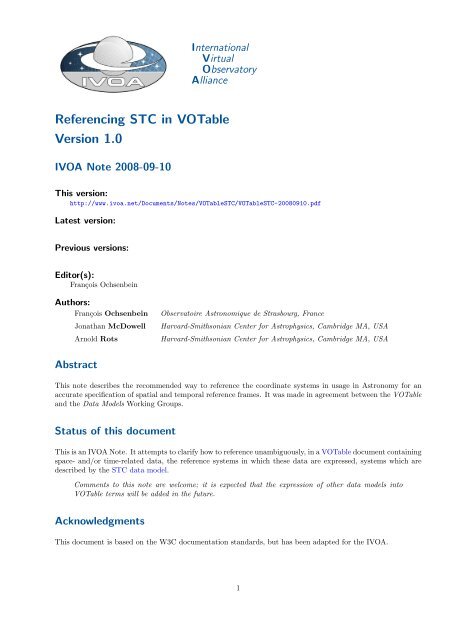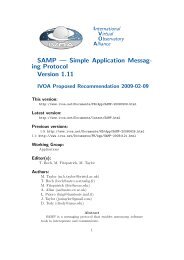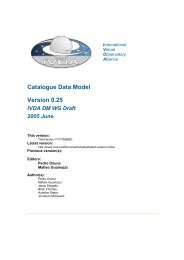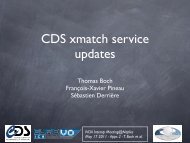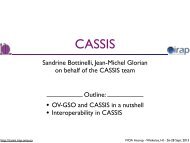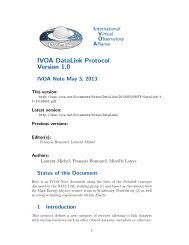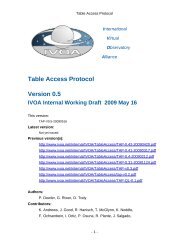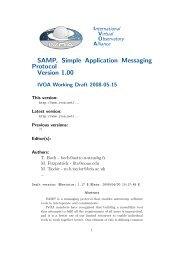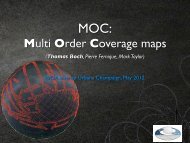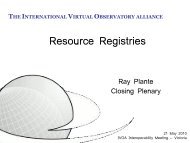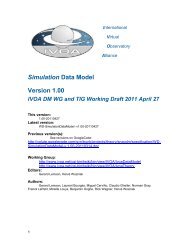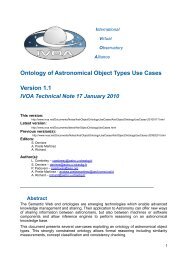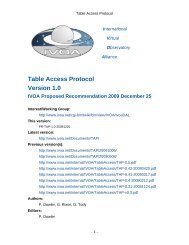Referencing STC in VOTable Version 1.0 - IVOA
Referencing STC in VOTable Version 1.0 - IVOA
Referencing STC in VOTable Version 1.0 - IVOA
You also want an ePaper? Increase the reach of your titles
YUMPU automatically turns print PDFs into web optimized ePapers that Google loves.
International<br />
Virtual<br />
Observatory<br />
Alliance<br />
<strong>Referenc<strong>in</strong>g</strong> <strong>STC</strong> <strong>in</strong> <strong>VOTable</strong><br />
<strong>Version</strong> <strong>1.0</strong><br />
<strong>IVOA</strong> Note 2008-09-10<br />
This version:<br />
http://www.ivoa.net/Documents/Notes/<strong>VOTable</strong><strong>STC</strong>/<strong>VOTable</strong><strong>STC</strong>-20080910.pdf<br />
Latest version:<br />
Previous versions:<br />
Editor(s):<br />
François Ochsenbe<strong>in</strong><br />
Authors:<br />
François Ochsenbe<strong>in</strong><br />
Jonathan McDowell<br />
Arnold Rots<br />
Observatoire Astronomique de Strasbourg, France<br />
Harvard-Smithsonian Center for Astrophysics, Cambridge MA, USA<br />
Harvard-Smithsonian Center for Astrophysics, Cambridge MA, USA<br />
Abstract<br />
This note describes the recommended way to reference the coord<strong>in</strong>ate systems <strong>in</strong> usage <strong>in</strong> Astronomy for an<br />
accurate specification of spatial and temporal reference frames. It was made <strong>in</strong> agreement between the <strong>VOTable</strong><br />
and the Data Models Work<strong>in</strong>g Groups.<br />
Status of this document<br />
This is an <strong>IVOA</strong> Note. It attempts to clarify how to reference unambiguously, <strong>in</strong> a <strong>VOTable</strong> document conta<strong>in</strong><strong>in</strong>g<br />
space- and/or time-related data, the reference systems <strong>in</strong> which these data are expressed, systems which are<br />
described by the <strong>STC</strong> data model.<br />
Comments to this note are welcome; it is expected that the expression of other data models <strong>in</strong>to<br />
<strong>VOTable</strong> terms will be added <strong>in</strong> the future.<br />
Acknowledgments<br />
This document is based on the W3C documentation standards, but has been adapted for the <strong>IVOA</strong>.<br />
1
Contents<br />
1 Introduction 3<br />
2 The space-time coord<strong>in</strong>ates 3<br />
3 The utype attribute 3<br />
4 Specify<strong>in</strong>g coord<strong>in</strong>ate components <strong>in</strong> <strong>VOTable</strong> 3<br />
5 Examples 4<br />
5.1 List of observations . . . . . . . . . . . . . . . . . . . . . . . . . . . . . . . . . . . . . . . . . . . . 5<br />
5.2 Extract of the Hipparcos catalog . . . . . . . . . . . . . . . . . . . . . . . . . . . . . . . . . . . . 6<br />
5.3 Ephemeride of Comets . . . . . . . . . . . . . . . . . . . . . . . . . . . . . . . . . . . . . . . . . . 8<br />
6 Summary of Interpretation and Defaults 10<br />
6.1 stc:AstroCoords components . . . . . . . . . . . . . . . . . . . . . . . . . . . . . . . . . . . . . . . 11<br />
6.2 stc:AstroCoordSystem components . . . . . . . . . . . . . . . . . . . . . . . . . . . . . . . . . . . 11<br />
7 References 12<br />
2
1 Introduction<br />
Astronomical catalogues are a very common source of tabular data, and among these the catalogs collect<strong>in</strong>g<br />
astronomical sources observed at specific sky locations and epochs have rout<strong>in</strong>ely to be compared to other<br />
catalogues conta<strong>in</strong><strong>in</strong>g <strong>in</strong>formations related to the same sources, but observed or modelled <strong>in</strong> different contexts:<br />
observations at different epochs, different wavelengths, simulated results, etc. An accurate knowledge of the<br />
mean<strong>in</strong>g of the parameters <strong>in</strong>cluded <strong>in</strong> these catalogues is therefore essential if one expects to derive scientifically<br />
significant conclusions from the comparisons of these data.<br />
The <strong>VOTable</strong> format is an <strong>IVOA</strong> standard which ensures that large data collections, which can be structured as<br />
a set of tables, can efficiently be exchanged with<strong>in</strong> the Virtual Observatory framework with a full understand<strong>in</strong>g<br />
of the data mean<strong>in</strong>g (the metadata). A lot of details may be required for a full description of the elements<br />
stored <strong>in</strong> these data collections, but the locations <strong>in</strong> space and time (the coord<strong>in</strong>ates, spatial and temporal) are<br />
essential if any comparison of the sources observed is attempted.<br />
The data <strong>in</strong> the context of the Virtual Observatory are described by data models, which formalize the context<br />
of the data for their accurate <strong>in</strong>terpretation. Data described <strong>in</strong> this way can then be more efficiently compared<br />
with data of similar nature but com<strong>in</strong>g out from other horizons, and valid conclusions or scientific results can<br />
be drawn with higher confidence.<br />
2 The space-time coord<strong>in</strong>ates<br />
In the context of astronomical catalogues, spatial (location <strong>in</strong> the sky) and temporal (date/time) parameters are<br />
one characterisation of virtually any observation, and these parameters are therefore fundamental if one wishes<br />
to make any comparison of the behaviour of the astronomical sources described <strong>in</strong> different catalogs – typically<br />
catalogs of observations made <strong>in</strong> widely different wavelength regimes. S<strong>in</strong>ce several systems are currently <strong>in</strong> use<br />
to express the spatial coord<strong>in</strong>ates, a dedicated COOSYS element was <strong>in</strong>troduced <strong>in</strong> the orig<strong>in</strong>al version (<strong>1.0</strong>) of<br />
<strong>VOTable</strong>: it did specify some m<strong>in</strong>imal level of details about the coord<strong>in</strong>ate system used <strong>in</strong> the table, and was<br />
merely an enumeration of the most commonly coord<strong>in</strong>ate frames used <strong>in</strong> astronomy (ICRS, historical equatorial<br />
frames, galactic, ecliptic, etc) associated to a couple of parameters (equ<strong>in</strong>ox and epoch). This <strong>VOTable</strong>-specific<br />
way of specify<strong>in</strong>g the frames used for spatial location is deprecated <strong>in</strong> <strong>VOTable</strong> version 1.2, <strong>in</strong> favor of a more<br />
generic way of specify<strong>in</strong>g the space and time coord<strong>in</strong>ates us<strong>in</strong>g the utype attributes and the GROUP constructs[1].<br />
3 The utype attribute<br />
<strong>VOTable</strong> is not a data model, it is more a conta<strong>in</strong>er for data which can be structured as tables, with emphasis<br />
on a s<strong>in</strong>gle description (the schema or metadata) for a potentially large number of elements (the tuples or rows).<br />
The description of the data cannot <strong>in</strong>clude all components of all the data models developed <strong>in</strong> the Virtual<br />
Observatory framework, but their accurate description requires to reference the data model, and to say how the<br />
various FIELDs compos<strong>in</strong>g the table are related to this data model. This relation — referenc<strong>in</strong>g a data model<br />
— is specified by the utype attribute, <strong>in</strong>troduced <strong>in</strong> the version 1.1 of <strong>VOTable</strong> for this purpose; utype can<br />
also be an attribute of the PARAM, GROUP, TABLE and RESOURCE elements [1].<br />
The syntax of the utype attribute has not yet been fixed <strong>in</strong> the Virtual Observatory context. This note assumes<br />
a syntax made from the model name (stc) followed by a colon (:), and the dot-separated hierarchy of elements,<br />
as e.g. stc:AstroCoords.Position2D.Value2.C1 to refer to first component of a 2-D astronomical coord<strong>in</strong>ate.<br />
The prefix (stc) should also be declared with the name space convention (as xmlns:stc=http://. . . ) to specify<br />
the version of the <strong>STC</strong> data model used.<br />
4 Specify<strong>in</strong>g coord<strong>in</strong>ate components <strong>in</strong> <strong>VOTable</strong><br />
The specification of an astronomical spatial and/or temporal coord<strong>in</strong>ates requires essentially 2 def<strong>in</strong>itions [2]:<br />
1. the def<strong>in</strong>ition of the coord<strong>in</strong>ate system (the frame <strong>in</strong> which the coord<strong>in</strong>ates are expressed), which can<br />
3
e an AstroCoordSystem (for astronomically def<strong>in</strong>ed frames) or a more generic CoordSys entity; these<br />
def<strong>in</strong>itions may however be omitted <strong>in</strong> the case of coord<strong>in</strong>ate systems referenced <strong>in</strong> the <strong>STC</strong> library (see<br />
the example <strong>in</strong> section 5.1)<br />
2. what is the exact role of the numbers listed <strong>in</strong> the document, which is def<strong>in</strong>ed by the AstroCoords element<br />
<strong>in</strong> the astronomical context, or by the Coords element <strong>in</strong> a more generic context.<br />
In a <strong>VOTable</strong> context, the utype attribute is used to specify the exact role of a specific field or parameter with<strong>in</strong><br />
the <strong>STC</strong> data model. The utype is an attribute of the FIELD element, and for <strong>in</strong>stance the right ascension and<br />
decl<strong>in</strong>ation components are def<strong>in</strong>ed by the attributes utype="stc:AstroCoords.Position2D.Value2.C1" and<br />
utype="stc:AstroCoords.Position2D.Value2.C2" respectively.<br />
The full specification of the <strong>STC</strong> components <strong>in</strong> a <strong>VOTable</strong> is constructed with 2 GROUPs which follow the <strong>STC</strong><br />
hierarchy:<br />
1. the coord<strong>in</strong>ate system (AstroCoordSystem) is specified <strong>in</strong> a <strong>VOTable</strong> GROUP conta<strong>in</strong><strong>in</strong>g the necessary<br />
PARAMeters or PARAMrefs to completely specify the coord<strong>in</strong>ate system; this GROUP must have the attributes<br />
• utype="stc:AstroCoordSystem"<br />
• ID="coordSys name", where coordSys name is any name which satisfies the ID/IDREF requirements<br />
(beg<strong>in</strong> with a letter, and conta<strong>in</strong> alphanumeric characters or the underscore without any whitespace).<br />
such that it can be referenced from the utype="stc:AstroCoords" group (item#2)<br />
This group may be omitted <strong>in</strong> the case where the coord<strong>in</strong>ate system is part of the <strong>STC</strong> library [2].<br />
2. the coord<strong>in</strong>ates components are grouped <strong>in</strong> a GROUP element with the properties:<br />
• the attribute utype="stc:AstroCoords"<br />
• an attribute ref="coordSys name" where coordSys name is the ID assigned <strong>in</strong> the first GROUP. A coord<strong>in</strong>ate<br />
system exist<strong>in</strong>g <strong>in</strong> the <strong>STC</strong> library may be referenced by a ivo://<strong>STC</strong>lib/CoordSys identifier<br />
(see section 5.1)<br />
• an attribute ID="coordGroup name" such that the group can be referenced from FIELD elements; like<br />
coordSys name, the coordGroup name assigned name must satisfy the ID/IDREF requirements.<br />
This GROUP may <strong>in</strong>clude PARAMeters to qualify the coord<strong>in</strong>ates if needed, and/or FIELDref references (see<br />
the examples below).<br />
3. f<strong>in</strong>ally the <strong>in</strong>dividual coord<strong>in</strong>ates, def<strong>in</strong>ed as FIELD elements, must have the attributes<br />
• utype="stc:AstroCoords.cootype.coorep.comp" which specifies the role of the field <strong>in</strong> the <strong>STC</strong><br />
data model. The italicized components are:<br />
– cootype can be "Position2D" for spherical coord<strong>in</strong>ates, "Position3D" for 3-D coord<strong>in</strong>ates, "Time"<br />
for the time axis;<br />
– coorep is the coord<strong>in</strong>ate representation: "TimeInstant" for the time axis, "Value2" for spherical<br />
coord<strong>in</strong>ates, "Value3" for 3-D coord<strong>in</strong>ates (cartesian or spherical, depend<strong>in</strong>g on the parameter<br />
def<strong>in</strong><strong>in</strong>g the flavour, which is characterized by utype="stc:AstroCoordSystem.SpaceFrame.CoordFlavor<br />
– comp <strong>in</strong>dicates the component: "C1", "C2", "C3" for the spatial axes, "ISOTime", "MJDTime"<br />
or one of the other times def<strong>in</strong>ed <strong>in</strong> the <strong>STC</strong> [2] for the axis time.<br />
• ref="coordGroup name" which refers to the GROUP def<strong>in</strong>ed <strong>in</strong> item#2 (hav<strong>in</strong>g the utype="stc:AstroCoords").<br />
It is quite possible to have several groups of coord<strong>in</strong>ates <strong>in</strong> a s<strong>in</strong>gle table, either <strong>in</strong> a common system (a common<br />
value of the ref attribute of the GROUPs hav<strong>in</strong>g utype="stc:AstroCoordSystem"), or <strong>in</strong> several different<br />
systems.<br />
5 Examples<br />
Three examples are given here. The first one uses the <strong>STC</strong>lib described <strong>in</strong> the Appendix C of the <strong>STC</strong> model<br />
[2], the other two give a more complete def<strong>in</strong>ition of the coord<strong>in</strong>ate system used.<br />
In all examples, we emphasize with different colors the <strong>STC</strong>-related utypes and the correspond<strong>in</strong>g ID/ref<br />
attributes to visualize their role <strong>in</strong> the XML output below. We draw attention to the possibility of the double<br />
referenc<strong>in</strong>g, that is:<br />
4
1. each FIELD which represents a component of the space-time coord<strong>in</strong>ates is referenc<strong>in</strong>g the "AstroCoords"<br />
GROUP. This reference is required to ensure a correct <strong>in</strong>terpretation (made by ref="Coo1" <strong>in</strong> the first<br />
example below)<br />
2. with<strong>in</strong> the "AstroCoords" GROUP, the components may be enumerated by means of FIELDref elements.<br />
This second referenc<strong>in</strong>g is optional.<br />
5.1 List of observations<br />
This simple example of a <strong>VOTable</strong> document lists 3 observations made with a telescope; each observation is<br />
characterized by the location of the CCD center, date/time of observation, and the exposure time. The XML<br />
serialisation looks like the follow<strong>in</strong>g:<br />
<br />
<br />
<br />
<br />
Observation log<br />
<br />
<br />
<br />
<br />
<br />
<br />
<br />
<br />
<br />
<br />
<br />
<br />
<br />
<br />
035.0798-05.23362005-11-01T12:00:551200<br />
<br />
<br />
035.0547-05.22532005-11-01T12:25:20600<br />
<br />
<br />
035.0463-05.25032005-11-01T12:36:20600<br />
<br />
<br />
<br />
<br />
5
<br />
The spherical coord<strong>in</strong>ates (RAJ2000, DEJ2000) def<strong>in</strong>ed as FIELDs have their utype attribute which specify<br />
their role <strong>in</strong> the <strong>STC</strong> model; their ref="Coo1" attribute designates the GROUP hav<strong>in</strong>g the attribute ID="Coo1".<br />
In this example the coord<strong>in</strong>ate system (UTC-ICRS-TOPO) is known <strong>in</strong> the <strong>STC</strong> library (see Appendix C of<br />
[2]), which is enough to fully def<strong>in</strong>e the time reference (UTC), the frame orientation (ICRS) and the reference<br />
po<strong>in</strong>t (TOPOcentric).<br />
5.2 Extract of the Hipparcos catalog<br />
The Hipparcos catalog is the primary realization of the International Celestial Reference System (ICRS) for<br />
optical wavelengths. Its positions and proper motions are given for the epoch J1991.25 (roughly the mid-po<strong>in</strong>t<br />
of the mission). The astrometric frame is barycentric (the barycenter of the Solar system is assumed to be the<br />
orig<strong>in</strong> of the frame); and the times used throughout the Hipparcos catalog (for the epoch photometry) is the<br />
geocentric terrestrial time [3].<br />
Notice that the GROUP def<strong>in</strong><strong>in</strong>g the coord<strong>in</strong>ate system (first group below) is itself made of 2 groups, one for the<br />
def<strong>in</strong>ition of the time axis, and the second for the def<strong>in</strong>ition of the spatial axes.<br />
<br />
<br />
<br />
<br />
<br />
<br />
<br />
<br />
<br />
<br />
<br />
<br />
<br />
<br />
<br />
<br />
<br />
<br />
A (t<strong>in</strong>y) excerpt from the Hipparcos catalog<br />
<br />
<br />
value="J1991.25" /> <br />
<br />
<br />
<br />
<br />
<br />
<br />
Identifier (HIP number) (H1)<br />
<br />
<br />
Magnitude <strong>in</strong> Johnson V (H5)<br />
<br />
<br />
<br />
alpha, degrees (ICRS, Epoch=J1991.25) (H8)<br />
<br />
<br />
delta, degrees (ICRS, Epoch=J1991.25) (H9)<br />
<br />
<br />
? Trigonometric parallax (H11)<br />
<br />
<br />
Proper motion mu alpha.cos(delta) ICRS(H12)<br />
(for J1991.25 epoch)<br />
<br />
<br />
? Proper motion mu delta, ICRS (H13)<br />
(for J1991.25 epoch)<br />
<br />
<br />
Standard error <strong>in</strong> Plx (H16)<br />
<br />
<br />
<br />
<br />
19.100.00091185<strong>1.0</strong>8901332<br />
3.54-5.20-1.881.39<br />
<br />
<br />
29.270.00379737-19.49883745<br />
21.90181.21-0.933.10<br />
<br />
<br />
36.610.0050079538.85928608<br />
2.815.24-2.910.63<br />
<br />
<br />
48.060.00838170-51.89354612<br />
7
7.7562.850.160.97<br />
<br />
<br />
58.550.00996534-40.59122440<br />
2.872.539.071.11<br />
<br />
<br />
<br />
<br />
<br />
<br />
5.3 Ephemeride of Comets<br />
This example gives the position of the comet 125P as a function of time. Notice that the planetary model used is<br />
added there via a PARAM hav<strong>in</strong>g utype="stc:AstroCoordSystem.SpaceFrame.ReferencePosition.PlanetaryEphem"<br />
<br />
<br />
<br />
<br />
<br />
<br />
<br />
<br />
<br />
<br />
<br />
<br />
<br />
<br />
<br />
Planetary theory used to compute the ephemeris of the planets<br />
<br />
<br />
<br />
<br />
<br />
<br />
<br />
<br />
Ephemeris of comet 125P <strong>in</strong> July 2007<br />
8
<br />
<br />
<br />
<br />
<br />
<br />
Date UTC <br />
<br />
<br />
alpha, degrees<br />
<br />
<br />
delta, degrees<br />
<br />
<br />
Distance from geocenter <br />
<br />
<br />
Visual magnitude<br />
<br />
<br />
<br />
<br />
2454284.0180.1745177+10.2710289<br />
1.46882572517.06<br />
<br />
<br />
2454286.0181.2970157+09.8077289<br />
1.47679882917.07<br />
<br />
<br />
2454288.0182.4335757+09.3344139<br />
1.484770578 17.09<br />
<br />
<br />
2454290.0183.5839061+08.8513908<br />
1.49275003317.11<br />
<br />
<br />
2454292.0184.7477408+08.3589893<br />
1.50074524217.13<br />
<br />
<br />
<br />
<br />
<br />
<br />
9
6 Summary of Interpretation and Defaults<br />
A VOTABLE resource may conta<strong>in</strong> multiple TABLEs and each of these tables may conta<strong>in</strong> many header PARAMs and<br />
many FIELD columns, possibly giv<strong>in</strong>g several sets of positions and times <strong>in</strong> several different coord<strong>in</strong>ate systems.<br />
For any PARAM or FIELD that gives an <strong>STC</strong> utype, there must be a ref attribute po<strong>in</strong>t<strong>in</strong>g to the GROUP that<br />
conta<strong>in</strong>s the <strong>STC</strong> AstroCoords (or Coords) def<strong>in</strong>ition. This is how we tie a particular utype to a particular<br />
<strong>STC</strong> <strong>in</strong>stance. For example:<br />
<br />
says that the column <strong>in</strong> question conta<strong>in</strong>s the Time value for an AstroCoords <strong>in</strong>stance whose frame is def<strong>in</strong>ed<br />
<strong>in</strong> the group which beg<strong>in</strong>s with .<br />
An AstroCoords <strong>in</strong>stance may conta<strong>in</strong> all of space, time, spectral and redshift coord<strong>in</strong>ates. It is often mean<strong>in</strong>gful<br />
to omit the spectral and redshift coord<strong>in</strong>ates. Space and time coord<strong>in</strong>ates are usually more tightly coupled.<br />
While <strong>in</strong> practice for some common coord<strong>in</strong>ate systems and astronomical contexts it is reasonable to give a<br />
position with no time, or a time not explicitly tied to a position, this is not recommended.<br />
This AstroCoords <strong>in</strong>stance <strong>in</strong> turn conta<strong>in</strong>s a reference to the relevant AstroCoordSystem (or CoordSys) used,<br />
either to a group hav<strong>in</strong>g a stc:AstroCoordSystem (or stc:CoordSys) utype, or with an appropriate refence to<br />
the<br />
bf <strong>STC</strong>lib component.<br />
Table 1: Most important stc:AstroCoords components <strong>in</strong> FIELD elements<br />
utype ucd Comments<br />
stc:AstroCoords.Time... time components (1) .<br />
TimeInstant.ISOTime time.start;obs.exposure Date with ISO-8601 convention (e.g.<br />
2008-10-25T12:14:15)<br />
TimeInstant.JDTime time.start Julian date, applies to e.g. a variable phenomenon<br />
(e.g. 2454765.09323)<br />
TimeInstant.TimeOrig<strong>in</strong>.JDTime time Reference date<br />
TimeInstant.TimeOffset time Time elapsed s<strong>in</strong>ce the TimeOrig<strong>in</strong><br />
stc:AstroCoords.Position2D... position on the celestial sphere<br />
Value2.C1 pos.eq.ra Right ascension or longitude<br />
Value2.C2 pos.eq.dec Decl<strong>in</strong>ation or Latitude<br />
Error2Radius stat.error;pos.eq Error radius of the spherical position<br />
Error2.C1 stat.error;pos.eq.ra Error on the Right Ascension or Longitude<br />
Error2.C2 stat.error;pos.eq.dec Error on the Decl<strong>in</strong>ation or Latitude<br />
stc:AstroCoords.Velocity2D... proper motion on the celestial sphere<br />
Velocity1D pos.pm Total proper motion<br />
Velocity2D.C1 pos.pm;pos.eq.ra Proper motion <strong>in</strong> RA or Longitude<br />
Error2.C1 stat.error;pos.pm;pos.eq.ra Error on a proper motion <strong>in</strong> RA or Longitude<br />
stc:AstroCoords.Position3D... position <strong>in</strong> a 3-D spherical system (2) , as <strong>in</strong> section 5.3example 3<br />
Value3.C1 pos.ecliptic.lon Ecliptic longitude<br />
Value3.C2 pos.ecliptic.lat Ecliptic latitude<br />
Value3.C3 pos.distance;pos.barycentric Distance to solar system barycenter<br />
(1) the reference position to which the time applies is def<strong>in</strong>ed <strong>in</strong> a parameter hav<strong>in</strong>g a utype<br />
stc:AstroCoordSystem.SpaceFrame.ReferencePosition<br />
(2) requires to specify a SPHERICAL frame (<strong>in</strong> stc:AstroCoordSystem.SpaceFrame.CoordFlavor component)<br />
and a value of 3 for the number of axes (<strong>in</strong> stc:AstroCoordSystem.SpaceFrame.coord naxes)<br />
10
6.1 stc:AstroCoords components<br />
The actual coord<strong>in</strong>ate components which are present <strong>in</strong> a <strong>VOTable</strong> as FIELDs are characterized by<br />
• a reference to a GROUP gather<strong>in</strong>g the coord<strong>in</strong>ate components, e.g. ref="Coo1"<br />
• their utype, e.g. utype="stc:AstroCoords.Position2D.Value2.C1" for the right ascension.<br />
• their ucd attribute, e.g. ucd="pos.eq.ra"<br />
• ... and the other attributes necessary for a correct <strong>in</strong>terpretation of the data: datatype, unit, width,<br />
precision, etc...<br />
Illustrations with actual examples are given <strong>in</strong> section 5the examples above; the most important utype and ucd<br />
attributes of use <strong>in</strong> this context are listed <strong>in</strong> Table 1. Many more parameters are actually available <strong>in</strong> the <strong>STC</strong><br />
model [2], which should be consulted for details.<br />
6.2 stc:AstroCoordSystem components<br />
The coord<strong>in</strong>ate systems used <strong>in</strong> a <strong>VOTable</strong>, if these are not part of the <strong>STC</strong> Standard Library (Appendix C<br />
of [2]), must be def<strong>in</strong>ed <strong>in</strong> GROUP elements hav<strong>in</strong>g the utype="stc:AstroCoordSystem" attribute, and an ID<br />
attribute to which the group of coord<strong>in</strong>ate elements def<strong>in</strong>ed above can refer.<br />
Table 2: Most important TimeScale values<br />
TT Terrestrial time<br />
TAI Temps Atomique International TT+32.184s<br />
UTC Coord<strong>in</strong>ated Universal Time TAI+leap seconds<br />
LST Local Sideral Time (needs ObservationLocation)<br />
LOCAL Local def<strong>in</strong>ition<br />
Table 3: Most important ReferencePosition values<br />
TOPOCENTER local position, on the surface of Earth Location should be specified<br />
GEOCENTER center of Earth<br />
HELIOCENTER center of Sun<br />
BARYCENTER barycenter of the Solar System<br />
LSR<br />
Local Standard of Rest<br />
GALACTIC CENTER center of our Galaxy<br />
Table 4: Most important astronomical frame types<br />
SPHERICAL Spherical coord<strong>in</strong>ates, 2-D (2 angles) and 3-D(additional distance) coord naxes required for 3-D<br />
CARTESIAN Cartesian frame<br />
POLAR Longitude + polar distance<br />
The temporal, spatial (and eventually the spectral, velocity / redshift) components are def<strong>in</strong>ed as subgoups<br />
with the appropriate utypes, follow<strong>in</strong>g the schema:<br />
11
<br />
<br />
<br />
<br />
<br />
<br />
<br />
<br />
<br />
<br />
<br />
<br />
<br />
The most frequent values of the parameters def<strong>in</strong><strong>in</strong>g the time are summarized <strong>in</strong> Table 2 (time scales) and<br />
Table 3 (reference location of time measurement); among the parameters which def<strong>in</strong>e a spatial frame, Table 3<br />
def<strong>in</strong>es the orig<strong>in</strong> of the frame (which may differ from the reference location of time measurements), Table 4<br />
def<strong>in</strong>es the frame type and dimensionality (standard frames used <strong>in</strong> astrometry are 2-D spherical), and Table 5<br />
summarized the most frequently frames used <strong>in</strong> astrometry.<br />
Table 5: Most important astronomical frame values<br />
ICRS International Reference System Compatible with FK5(J2000)<br />
FK5 Equatorial frame based on FK5 Requires the Equ<strong>in</strong>ox (default J2000)<br />
FK4 Equatorial frame based on FK4 Requires the Equ<strong>in</strong>ox (default B1950)<br />
ECLIPTIC Ecliptic frame Requires the Equ<strong>in</strong>ox ((default J2000)<br />
GALACTIC Galactic frame Also named GALACTIC II<br />
SUPER GALACTIC Local Group<br />
J2000<br />
Equatorial on FK5, Equ<strong>in</strong>ox=J2000<br />
B1950<br />
Equatorial on FK4, Equ<strong>in</strong>ox=B1950<br />
7 References<br />
[1] François Ochsenbe<strong>in</strong>, et al. <strong>VOTable</strong> Recommendation<br />
http://ivoa.net/Documents/latest/<strong>VOTable</strong>.html<br />
[2] Arnold Rots Space-Time Coord<strong>in</strong>ate Metadata for the Virtual Observatory (v1.30)<br />
http://ivoa.net/Documents/latest/<strong>STC</strong>.html<br />
[3] The Hipparcos and Tycho Catalogues, ESA SP1200 June 1997, Vol.1, section 1.2 (also available <strong>in</strong> PDF)<br />
12


